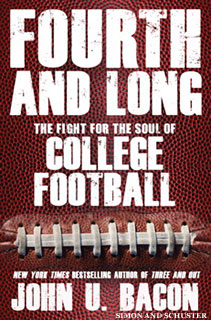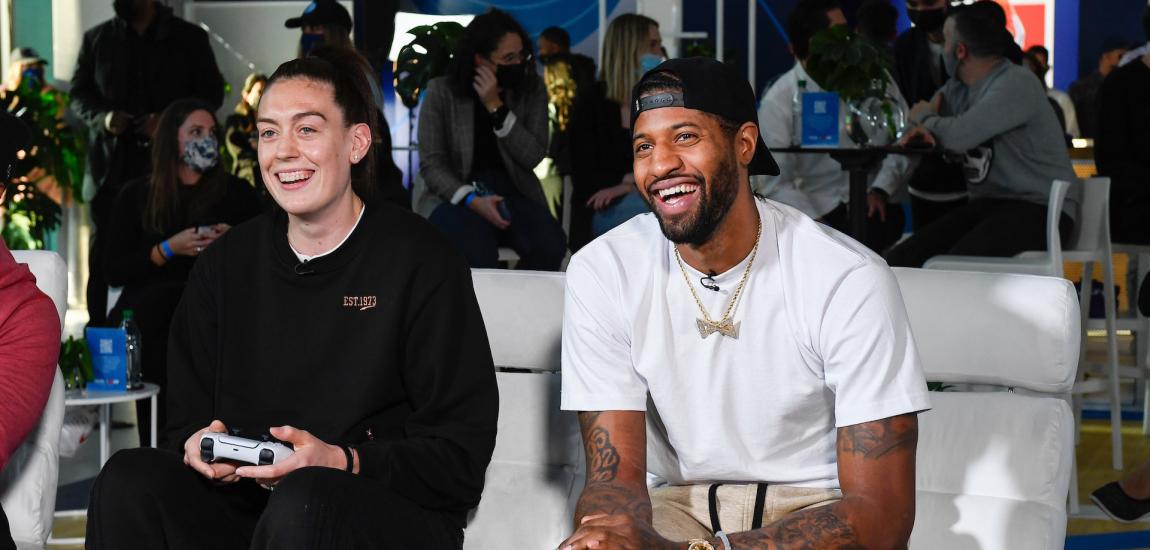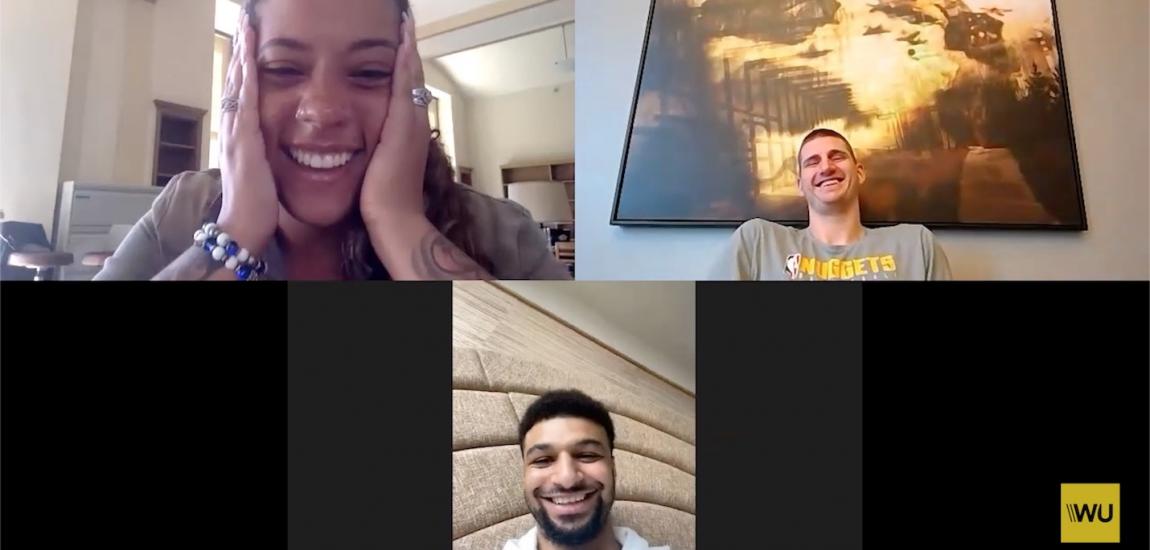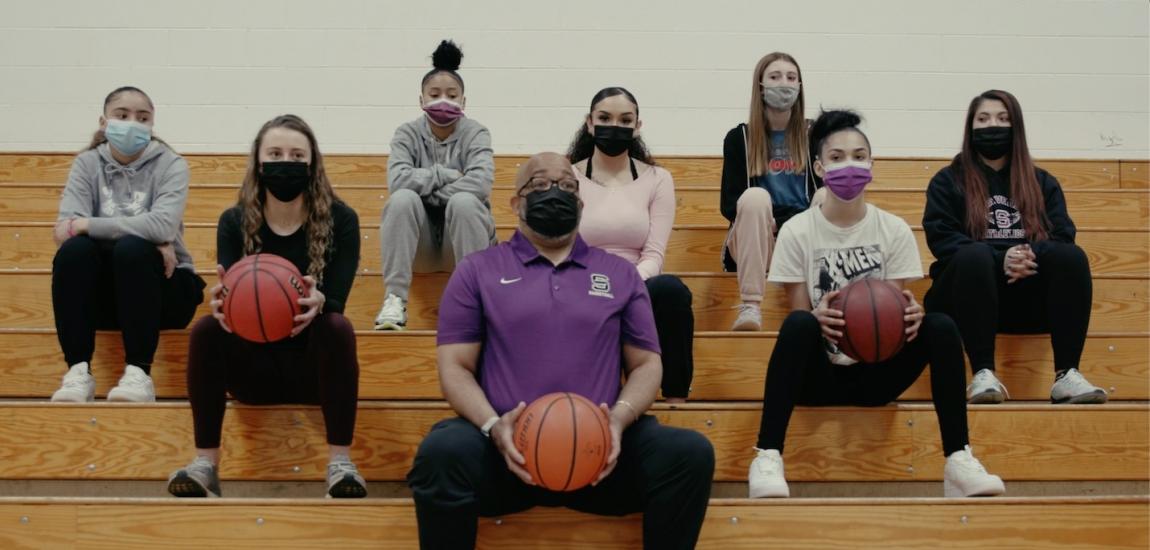
Big Ten Commissioner Jim Delany -- who might be the smartest man in college sports -- stood outside the Big Ten's brand new offices recently, telling a group of reporters, "Maybe in football and basketball, it would work better if more kids had a chance to go directly into the professional ranks. If they're not comfortable and want to monetize, let the minor leagues flourish.”
It isn't clear if Delany's comments reflected his deeply held beliefs, an offhand comment, or just a daring bluff – but if it's the latter, it isn't as daring as it seems.
By challenging the NFL and NBA to start their own minor leagues, Delany doesn't have much to lose. He knows they won't, because they have every reason not to. They've used the college leagues to develop their players from the day the pro leagues started. Why would they derail the gravy train now?
And even if they did, it wouldn't cost the Big Ten much, if anything.
But if we call Delany's bluff and play it out, we'll see it leads to one idea that could actually save what we love most about college football: the passion no other sport can match.
I came to the same conclusion Delany did several years ago, though for different reasons.
Working on a book proposal a decade ago, I was struck by the essential difference between American football and basketball on the one hand, and just about every sport in the world on the other: football and basketball developed primarily as college games. When the NFL and NBA opened decades later, they simply hired the best college players available, but it still took the pro leagues decades to challenge the popularity of college football and basketball. The NFL didn't get a permanent foothold until the classic 1958 title between the New York Giants and the Baltimore Colts, and the NBA Finals were still on tape-delay until Magic and Bird joined the league in 1979.
Why does this matter? Because by starting after college football and basketball were already established, the NFL and NBA were freed from having to develop viable minor leagues of their own, making them virtually the only sports in the world that don't have them. Roughly a century ago, Major League Baseball and the NHL could not rely on the nascent college programs to fill their rosters, so they had to create their own minor leagues.
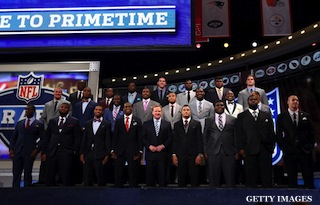
And that's why today, almost every high school football and basketball star has just one path to the big leagues: the NCAA. This makes no sense. Athletes and universities can benefit each other, but they shouldn't need to. Pele never had to worry about passing 12 credits before playing in his first World Cup, and the University of Chicago figured out it didn't need a football team to be a world-class university. As former University of Chicago president Robert Maynard Hutchins liked to say, “Football is to education as bullfighting is to agriculture.” He backed it up in 1939, when he pulled the Maroons out of the Big Ten. Today, Chicago's admissions department is the fourth most selective in the country, behind only those of Harvard, Yale and Princeton.
When a committed student-athlete enrolls in a four-year college, everyone involved receives at least some benefit. The athlete gets a free education, an enduring asset no matter what he does on the field, and the college enjoys reflected glory from his performance. But when we require a gifted athlete with little or no interest in higher education to enroll in a four-year college to get to the NFL or NBA, he is more likely to fail in the classroom, which may actually prevent him from pursuing a promising athletic career – something that happens only in America – and the school's academic reputation will take a very public hit. Nobody wins.
So, how do we fix this?
Everyone agrees it's increasingly difficult to support the farce that the NCAA is foisting upon us, but we can't agree on how to fix it. In recent years we've seen proposals ranging from school-sponsored minor league teams to ending big-time college sports altogether.
The most popular idea sits between those two extremes: give up the ruse, and pay the players. After all, everyone seems to be making millions off the athletes, except the athletes.
Consider the skyrocketing salaries of Division I football coaches, which now average more than $2 million a year, an increase of 750 percent (adjusted for inflation) since 1984, about twenty times more than professors' salaries increased over the same period. In 2012, the highest-paid state employee in twenty-seven states was a football coach, and in thirteen it was a basketball coach. The number of states whose highest-paid public employee was a university president? Four. The explosion in CEO pay, and the rationales that go with it, would be a fair comparison.
This chasm between the value of the players' scholarships and their coaches' salaries will only become more obscene with the arrival of the four-team playoff this season, whose TV rights alone will be worth $5.64 billion over twelve years, or about $470 million a year -- all for three games. In the NCAA basketball tournament this past spring, March Madness generated $1 billion –- in ad revenue alone.
As I wrote in Fourth and Long:
The most serious threat to big-time college athletics is not the endless scandals, which affect only those who get caught, but the rampant greed, which affects everybody. As Michael Kinsley has famously said, "The scandal isn't what's illegal. The scandal is what's legal.”
With so many millions sloshing around the athletes, it's no surprise they're reaching their limits. And it's not just “Johnny Football” Manziel, a uniquely unsympathetic figure, either, but Kain Colter, Northwestern's pre-med quarterback, who has taken to wearing an armband with “A.P.U.” on it, for All Players United, in support of those fighting to protect their rights, and their safety.
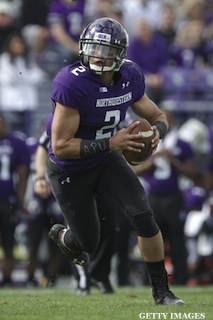
Certainly, the idea of giving the players a stipend of a thousand or two a year -- which the NCAA almost passed four decades ago -- so they can pay for a dinner date, a winter coat or a trip home, is long overdue. But even that modest proposal will cost more than its proponents imagine, since Title IX will dictate all scholarship athletes receive the same stipend, be they the All-American quarterback or the second-string coxswain on the women's crew team.
Thus, when people talk about $20,000 “salaries" for college athletes, the cost at the biggest programs, which have some 700 student-athletes, will quickly exceed $10 million. And before you know it, you're talking real money.
If you think for a second these payments will be deducted from the coaches' bloated salaries, I have a “Johnny Football” autograph to sell you. No, these salaries will be piled on to the mountain of money that college athletic departments already spend every year. And they will pay for that pile, of course, by extracting still more millions from alternate jersey sales, rising seat license “donations,” corporate partnerships, and the ads that come with them -- the very things that are alienating lifelong fans.
If I'm right that the biggest threat to college football is not scandal but greed, paying the players will only exacerbate the sport's central problem, setting up the kind of tug-of-wars we see in pro sports that turn everybody off. Pouring more gasoline on a fire will not make it smaller. Paying players will not solve the problem it is intended to solve -- the players will soon want more, just like the coaches, and not without reason -- but it will create many new problems that will threaten the future of the sport.
Universities already have a difficult time controlling their athletic departments, and the pay-to-play plans will not make it any easier. They will turn the student-athletes into bona fide employees, which will open a Pandora's box of legal issues, and questions from the IRS.
The pay-to-play proposals also assume the current record TV ratings, sweetheart corporate deals and sold-out stadiums will continue far into the future. But we've already seen plenty of signs that the fans are also nearing their breaking point.
Penn State fans travel an average of four hours to see their Nittany Lions play -- as hardcore as any fans in college football. But Penn State snapped its six-year streak of 100,000-plus crowds more than a year before Jerry Sandusky was arrested, thanks to an aggressive seat-license program. Three thousand fans dropped their season tickets in 2010, when the seat-license program was introduced, three thousand more did the next year, and the departures have only accelerated since. When I attended the University of Central Florida-Penn State game this fall, my friends estimated there were no more than 85,000 fans in the stands that night – no matter what they announced as the “official paid attendance."
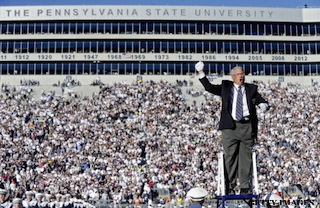
Penn State fans are not the canaries in the coalmine. They are the coalminers. And if they're starting to climb out of their favorite mine, no program is safe.
The cost for a family of four to attend a Michigan football game, with average seats and no hotel rooms or restaurant meals, runs about $500 – more than a day at Disneyworld. And Mickey never loses. While the Michigan athletic department claims the streak of 100,000-plus crowds, dating back to 1975, has never been broken, the game against Akron revealed wide swaths of empty seats, particularly in the student section – your future season ticket holders.
If you crank up the seat licenses, the TV timeouts and the endless ads another notch or two to pay players' salaries, you will risk losing a generation of fans, and the whole enterprise will erode. The question of paying the players will become truly academic if there's no money to pay them.
When did you last attend a boxing match or a horse race? If the bottom can fall out of those once robust sports, it can happen to college football, too. And if you like Off-Track Betting Parlors, and the empty stands they create, you're going to love the future of big-time college sports.
Despite the many good reasons to pay the players, I think there are better reasons not to -- and a better way to fix the problem that paying the players is intended to fix.
Delany might not be serious about his dare, but I am.
In my previous book, Three and Out, I wrote, “For those rare stars, I've always believed, the NFL and NBA should set up viable minor leagues to give such players a real choice -- the same one high school hockey and baseball players have."

That came out two years ago. The need for this change is much more urgent today.
What football and basketball players need is what baseball and hockey players have enjoyed for almost a century: a viable minor league, so players who don't want to be college students, and prefer to be paid in cash instead of scholarships, can do just that.
This would cut down on the majority of problems that beset both sports, almost overnight. Johnny Football? Sign all you want. "One and done” becomes "None and done." Go!
Delany's bold statement aside, you have to believe that if the NFL and NBA actually called his bluff, he might fear losing some of the NCAA's most exciting players to the new minor leagues – and with them, some of the appeal of college football and basketball.
Fret not. As I write in Fourth and Long:
We don't have to wonder if creating a separate minor league system will work. We already know: Just check out college hockey. The players who would rather have a paycheck than a scholarship can jump straight to the minor leagues – and they do. Because the players who opt for college are not forced to do so by the NHL, the graduation rates tend to be much higher in college hockey, and the scandals much fewer. College hockey fans love them all the more, because they know the guys they're cheering for have chosen to be college hockey players. They're the real deal.
In hockey, at least, both the minor leagues and the colleges deliver the players and the fans exactly what they promise. The only games they play are on the ice.
OK, but why would the NFL and NBA ever go for this, and voluntarily invest millions of their own money to create something they've been getting for free since they started? They wouldn't, of course, so you'd have to force them.
But forcing them can be accomplished in one step: bring back freshmen ineligibility. If you want to make it honest, that's how you do it.
In fact, freshmen ineligibility was the rule from 1905, the year the NCAA was founded, until 1972, and for a simple reason: colleges actually believed their athletes should be students first, and this is how they proved it. It gave all athletes a year to get their feet on the ground, and catch up where needed. Dean Smith and Terry Holland argued before the Knight Commission about the merits of freshmen ineligibility -- but that was nine years ago, and nothing has changed. Until the NCAA, the leagues, the presidents and the athletic directors bring back freshmen ineligibility, you should not take them seriously when they speak of “student-athletes.” They do not mean it.
By requiring allstudent-athletes to be actual student-athletes, many elite athletes will opt out -- but there's no way the NFL or the NBA will let talented 18-year olds wander off if they might be able to help their teams win games. So, the NFL and NBA would almost certainly do what they should have done decades ago: Prepare players for their leagues, with their own money, by starting their own minor league teams.
Creating two paths to the pros will throw a bucket of cold water on the overheated facilities arms race, the soaring coaches' salaries and the insane TV contracts. Yes, those things exist in college hockey and baseball, but nowhere near on the same scale. Restoring a sense of proportion is what we're seeking here.
Yes, we need other reforms, too. We need to put an end to the NCAA's absurd charade of posing as the sheriff when it's really the saloonkeeper. Universities should hire athletic directors who've spent their working lives nurturing student-athletes, not “maximizing the revenue streams” of their “brand.” And we should require all universities to reinstate true faculty oversight of their athletic programs.
"Without faculty control,” Michigan's legendary athletic director, Don Canham, wrote in an essay that came out after his death in 2005, “the presidents are running up to $70 million budget programs (Michigan, Ohio State, Stanford, Texas, etc.) with no oversight. What $70-million business could conduct business without a board of control?” In the eight years since Canham warned of “unbridled expansion,” Michigan's budget has more than doubled. Guess he knew something.
All these changes are needed, but creating a second path to the pros is the key. And -- as Smith, Holland and Canham himself urged -- restoring freshmen ineligibility is the way to do it.
No, this solution will not create a perfect world. There will still be athletes who aren't bona fide college students. There will still be coaches and boosters happy to break the rules. And there will still be an outsized mania for the sport. The goal is not perfection, but sanity -- to protect the integrity of the universities the players are representing, to protect the players from being trapped, and to preserve the passion the players and fans still feel for their favorite game.
The time to save this century-old game is now. And creating minor leagues to preserve college athletics, while giving all athletes a real choice, is the way to do it.
It's time to call Mr. Delany's bluff.
-- JOHN U. BACON is the author, most recently, of Fourth and Long: The Fight for the Soul of College Football, a New York Times bestseller. He gives weekly commentary on Michigan Radio, teaches at the University of Michigan and Northwestern's Medill School of Journalism, and speaks nationwide on leadership and diversity. Learn more at JohnUBacon.com.

